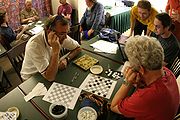
Konane
Encyclopedia

Board game
A board game is a game which involves counters or pieces being moved on a pre-marked surface or "board", according to a set of rules. Games may be based on pure strategy, chance or a mixture of the two, and usually have a goal which a player aims to achieve...
from Hawaii
Hawaii
Hawaii is the newest of the 50 U.S. states , and is the only U.S. state made up entirely of islands. It is the northernmost island group in Polynesia, occupying most of an archipelago in the central Pacific Ocean, southwest of the continental United States, southeast of Japan, and northeast of...
. It was invented by the ancient Hawaiian Polynesians. The game begins with all the counters laid out on the board in an alternating pattern of black and white. Players then hop over one another's pieces capturing them similar to checkers. The first player who can no longer make a capture is the loser, and the other player is the winner.
In ancient times, the pieces used were black and white lava stones played over a large rock which doubled as a board and table.
The game appears somewhat similar to draughts. Pieces hop over one another when capturing. However, the similarities end there. In draughts, one player's pieces are initially set up on one side of the board opposite the other player's pieces. In Konane, both players' pieces are intermixed in an alternating pattern of black and white that covers the whole board. Furthermore, in Konane all moves are capturing moves, and they are done in an orthogonal direction (not diagonally).
Konane's closest relative are Leap Frog
Leap Frog (board game)
Leap Frog is a multi-player abstract strategy board game. Several players can play at once which makes it great for parties and family get-togethers. The game is an old classic, and may have derived from Solitaire and draughts. It is essentially a multi-player version of Solitaire. A square...
and Tjuki
, and these games form a family of their own.
Goal
The first player unable to capture an enemy piece is the loser, and the other player is the winner. There are no draws in this game.Equipment
The game is played on a rectangular or a square board. Pieces can be laid out in the beginning of the game in an alternating pattern of two colors on top of a table, on the ground, or any flat surface. Furthermore, the game can be generalized to any size mathematically.Rules and Game Play
1. The game begins with all the pieces on the board (or table, ground, etc.) arranged in analternating pattern.
2. Players decide which colors to play (black or white).
3. Black traditionally starts first, and must remove one of its pieces from the "middle of the board", or from one of the four corners of the board.
There are 4 pieces (2 black and 2 white diagonally opposite each other) that form a 2 x 2 square array in the "middle of the board". Black can either remove one of those two black pieces, or remove a black piece from one of the four corners of the board. The four corners of the board will also consist of two black pieces and two white pieces that are diagonally opposite from each other.
4. White then removes one of its pieces orthogonally adjacent to the empty space created by Black. There are now two orthogonally adjacent empty spaces on the board.
5. From here on, players take turn capturing each other's pieces. All moves must be capturing moves. A player captures an enemy piece by hopping over it with their own piece similar to draughts. However, unlike draughts, captures can be done only orthogonally and not diagonally. The player's piece hops over the orthogonally adjacent enemy piece, and lands on a vacant space immediately beyond. The player's piece can continue to hop over enemy pieces but only in the same orthogonal direction. The player can stop hopping enemy pieces at any time, but must at least capture one enemy piece in a turn. After the piece has stopped hopping, the player's turn ends. Only one piece may be used in a turn to capture enemy pieces.
6. The player that can no longer make a capture is the loser, and the other player is the winner.
External links
- http://people.csail.mit.edu/mernst/pubs/konane-tr9524-abstract.html
- http://futrellsoftware.com/konane.php
- http://www.boardgamegeek.com/game/8122
- http://www.k12.hi.us/~gkaapuni/konane.htm
- http://cs.brynmawr.edu/Theses/Thompson.pdf

